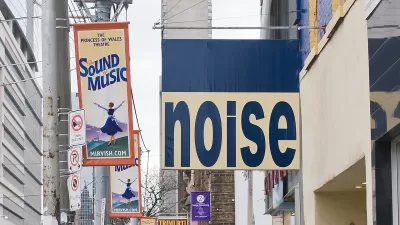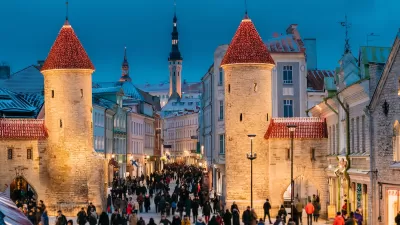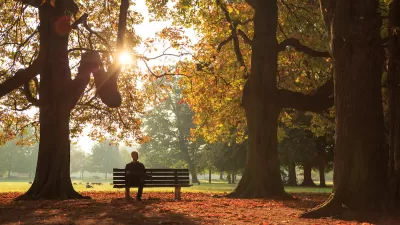The hustle and bustle of cities are part of the appeal, but too much noise is unhealthy. Planners can help control the problem of noise in the city.

Remember that scene in My Cousin Vinny where the main character—a sworn city-slicker—can't sleep in the silence and doesn't find relief until he lands in a noisy prison with the sirens blaring? No doubt many people from the city can laugh and relate.
Although city-dwellers may be used to noise pollution, that doesn't change the fact that exposure to excessive noise pollution can be detrimental to physical, mental, and emotional health.
Therefore, it’s imperative that city planners take proactive steps to cut down on noise pollution in metropolitan areas.
What Is Noise Pollution?
Noise pollution refers to excessive amounts of noise that interfere with the natural biorhythms of everyday life. Noise pollution can also come from sounds that aren't necessarily overly loud, but which are particularly annoying or troublesome in nature.
Some noise pollution stems from ineffective city planning. However, even in cities with a comprehensive noise pollution ordinance in place, circumstances often land beyond the planners' control—including construction, social events such as concerts, and the simple everyday business of industry.
To test for noise pollution in your area, simply take a minute to close your eyes and focus your awareness of what you hear. You might think, for example, that you work in a quiet office place—and this may be true overall.
However, even in the quietest environment, you will most likely hear the hum of electronic devices and florescent lights, traffic passing on the street below, or voices from other offices.
How Does Noise Pollution Affect Our Health?
Many believe the only physical effect of living in an area with excessive noise pollution is the occasional headache. While headaches can and do occur as a result of excessive environmental noisiness, this is far from the only detrimental health effect. Noise pollution creates problems for just about everybody.
Recent scientific studies have shown a strong correlation between environmental noise and an elevated risk for high blood pressure. Not only that, but in areas with excessive noise pollution, such as areas near airports, residents run a higher risk of heart attack and stroke.
Noise pollution also impacts children's growth and learning development. In areas in which excessive noise is often present, children show overall lower reading comprehension and logical reasoning skills than peers who grow up in more natural sound environments.
The correlation between noise pollution and mental health is more tenuous. It is unclear if those predisposed to mental health issues feel the impact of noise pollution more keenly or whether the pollution itself leads to mental illness.
Emotionally, though, long-term exposure to excessive noise correlates with a higher risk of depression, anxiety and insomnia.
Noise pollution also impacts animals and puts our pets at risk. Most pet owners realize that sudden loud noises—such as the sound of fireworks—panic their pets. Therefore, they take appropriate measures to protect their pets from thunderstorms and the like.
However, long-term exposure to noise pollution can lead to animal behavior problems and can even shorten the lives of our furry friends.
Solutions to Dealing With Noise Pollution
In an ideal world, cities would take measures to prevent noise pollution before it becomes excessive instead of waiting until their citizens' health is already at risk. However, in cities such as New York, which are already beleaguered with excessive noise, remedial measures may not just be appropriate, but also necessary.
One solution is to issue fines to businesses and individuals who violate noise ordinances. While this may discourage some from making excessive noise, others—especially large industries —might simply consider the fines to be a part of the cost of doing business and do nothing to change their practices.
Another approach involves planning for predictable noise pollution factors such as air traffic. Locating or relocating airports to areas far away from residents is a huge step in the right direction.
The city of Denver notably used this approach when replacing their previous airport with Denver International, which is located far from any homes and is surrounded by fields of sunflower crops.
Cities can also offer subsidies to residents to replace old windows with heavier, better-insulated ones, build soundproof barriers around highways and other major thoroughfares, reduce traffic speeds in metropolitan areas, and invest in new public transportation technologies such as light rail, which can carry large numbers of passengers to their destination without creating excessive noise pollution.
At an individual level, residents can also take steps to reduce noise pollution. Try to keep cell phones and televisions at a low noise level—especially during the evening and nighttime hours when many are trying to unwind and sleep. Dog owners can take measures to prevent their dogs from barking excessively for long periods of time by bringing them inside and using natural aromatherapy remedies to reduce pet stress.
By taking action at both the citywide and the individual level, we can minimize the impact of noise pollution on human health and development and create a more peaceful world for all.

Planetizen Federal Action Tracker
A weekly monitor of how Trump’s orders and actions are impacting planners and planning in America.

Restaurant Patios Were a Pandemic Win — Why Were They so Hard to Keep?
Social distancing requirements and changes in travel patterns prompted cities to pilot new uses for street and sidewalk space. Then it got complicated.

Map: Where Senate Republicans Want to Sell Your Public Lands
For public land advocates, the Senate Republicans’ proposal to sell millions of acres of public land in the West is “the biggest fight of their careers.”

Orange County, Florida Adopts Largest US “Sprawl Repair” Code
The ‘Orange Code’ seeks to rectify decades of sprawl-inducing, car-oriented development.

Maui's Vacation Rental Debate Turns Ugly
Verbal attacks, misinformation campaigns and fistfights plague a high-stakes debate to convert thousands of vacation rentals into long-term housing.

San Francisco Suspends Traffic Calming Amidst Record Deaths
Citing “a challenging fiscal landscape,” the city will cease the program on the heels of 42 traffic deaths, including 24 pedestrians.
Urban Design for Planners 1: Software Tools
This six-course series explores essential urban design concepts using open source software and equips planners with the tools they need to participate fully in the urban design process.
Planning for Universal Design
Learn the tools for implementing Universal Design in planning regulations.
Heyer Gruel & Associates PA
JM Goldson LLC
Custer County Colorado
City of Camden Redevelopment Agency
City of Astoria
Transportation Research & Education Center (TREC) at Portland State University
Camden Redevelopment Agency
City of Claremont
Municipality of Princeton (NJ)






























